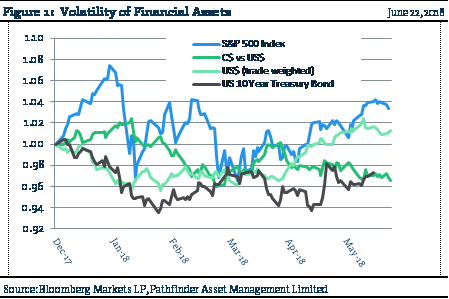Recap & Macro Outlook: Multiple Trade Wars?
In the last few Outlooks, we have focused on employment as a harbinger of the global economy. All things being equal, we believe that strong employment will continue to push the economy forward, increasing consumption and trade. We also believe that an increase in employment pushes inflation higher – i.e. increases in wages and other production costs. As inflation increases, both short-term interest rates and long-term interest rates increase. This slows the economy and forces changes in financial markets. Over the past number of weeks, we have written about participation rates, employment rates and wage growth data, always watching for a potential increase in inflation as an overriding thought. We regularly review economic data and speak with companies for a potential indication of that coming change.

Over the past couple of days, there has also been a lot of discussion about “trade wars” in the media. We are of two minds on this topic:
- Let’s assume there is a true trade war. We read an interesting statistic about a 10% tariff on washing machines applied in April 2018. This tariff did have an extremely small impact on overall inflation for that month, but did not follow through afterwards. If there were more tariffs applied as part of a trade war, we would expect a similar result magnified. As a result, we would expect consumption to slow. Just think, if you went shopping for a washing machine and saw the higher price, you may delay that purchase. That is the natural impact of inflation. When prices are high, people delay purchasing a discretionary item. This causes the economy to slow or even potentially fall into a recession if the change is dramatic enough. Trade wars are bad not because of inflation but because of the impairment to growth.
- Let’s assume that the US administration is just posturing with rhetoric for bargaining purposes (domestic or international) and that there is in fact no “trade war”. In that case our original thesis holds. Strong employment and low inflation results in an expanding global economy. No problems at all.
“This means that” we will continue to focus on investing in real businesses. We have no edge (no one does!) in figuring out what the US, Chinese, Canadian and European administrations will do with respect to bilateral trade relationships. We will be ever vigilant and buy companies with good businesses, with good management, at good prices.
National Instrument 31-103 requires registered firms to disclose information that a reasonable investor would expect to know, including any material conflicts with the firm or its representatives. Doug Johnson and/or Pathfinder Asset Management Limited are an insider of companies periodically mentioned in this report. Please visit www.paml.ca for full disclosures.
*All returns are time weighted and net of investment management fees. Returns from the Pathfinder Partners’ Fund and Partners’ Real Return Plus Fund are presented based on the masters series of each fund. The Pathfinder Core: Equity Portfolio and The Pathfinder Core: High Income Portfolio are live accounts. These are actual accounts owned by the Pathfinder Chairman (Equity) and client (High Income) which contain no legacy positions, cash flows or other Pathfinder investment mandates or products. Monthly inception dates for each fund and portfolio are as follows: Pathfinder Core: Equity Portfolio (January 2011), Pathfinder Core: High Income Portfolio (October 2012) Partners’ Fund (April 2011), Partners’ Real Return Plus Fund (April, 2013), and Partners’ Core Plus Fund (November 2014).
Pathfinder Asset Management Limited (PAML) and its affiliates may collectively beneficially own in excess of 10% of one or more classes of the issued and outstanding equity securities mentioned in this newsletter. This publication is intended only to convey information. It is not to be construed as an investment guide or as an offer or solicitation of an offer to buy or sell any of the securities mentioned in it. The author has taken all usual and reasonable precautions to determine that the information contained in this publication has been obtained from sources believed to be reliable and that the procedures used to summarize and analyze such information are based on approved practices and principles in the investment industry. However, the market forces underlying investment value are subject to sudden and dramatic changes and data availability varies from one moment to the next. Consequently, neither the author nor PAML can make any warranty as to the accuracy or completeness of information, analysis or views contained in this publication or their usefulness or suitability in any particular circumstance. You should not undertake any investment or portfolio assessment or other transaction on the basis of this publication, but should first consult your portfolio manager, who can assess all relevant particulars of any proposed investment or transaction. PAML and the author accept no liability of any kind whatsoever or any damages or losses incurred by you as a result of reliance upon or use of this publication.